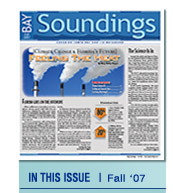 |
||||||||

The Science Is In
|
By Mary Kelley Hoppe
Around the globe and here in Florida, the question mark is being dropped from discussions about global warming. Lingering skepticism was further eroded when the United Nations Intergovernmental Panel on Climate Change (IPCC) released its latest report in February.
The IPCC calls global warming “unequivocal” and “very likely” (more than 90% probability) the result of human activities, chiefly fossil fuel burning and, to a lesser but significant extent, land-use change.
In its Fourth Assessment, the most complete climate change science overview to date, the IPCC projects more drought, more ferocious storms, shrinking glaciers, and rising seas that would threaten low-lying coasts from Florida to Bangladesh, cities from Shanghai to Buenos Aires, and islands across the Pacific. Over the last century, average global temperatures have risen about 1.4 F degrees, with most of the observed increases since the mid-20th century “very likely” due to the observed increase in greenhouse gases including carbon dioxide (CO2). By 2100, temperatures are expected to rise 2-10 degrees F if global warming pollution continues unabated.
Similar temperatures changes have occurred in the past, but they transpired over centuries and millennia instead of decades. According to the IPCC, the last time the polar regions were significantly warmer than they are now for an extended period (about 125,000 years ago), polar ice melt led to sea level rise of 12 to 18 feet. Ice core analysis indicates that atmospheric concentrations of CO2 are far higher now than in the past 650,000 years. What’s more, the increase has soared since the dawn of the industrial era (280 ppm versus 379 ppm in 2005, or about 35%), with the largest growth rate occurring in the last decade. There is now broad scientific consensus that greenhouse gases must be reduced by 60 to 80% of 2000 levels by 2050 to avoid dangerous anthropogenic climate change, including sea level rise of three feet or more.
| What is climate change? The climate of the Earth is always changing. In the past it has changed as a result of natural causes. Nowadays, however, the term climate change is generally used when referring to changes in our climate that have been identified since the early part of the 1900s. The changes over recent years, and those predicted over the next century, are thought to be mainly as a result of human activities rather than natural changes in the atmosphere. The greenhouse effect is very important in discussions about climate change as it relates to the gases that keep the Earth warm. It is the extra greenhouse gases which humans have released that are thought to pose the strongest threat. Source: BBC |
Global Context: Shrinking Ice, Rising Seas
The IPCC estimates global average sea level rise of 7 to 23 inches this century, but those figures exclude factors they couldn’t model. Omissions include both dynamic ice flow and carbon-cycle feedbacks from melting of the permafrost, which would release huge amounts of long-frozen carbon back into the atmosphere.
The big wild cards are Greenland and the West Antarctic ice sheets.
In Greenland, where average temperatures rose 11 degrees F from 1991 to 2003, new research confirms dramatic melting. A NASA-supported study released in September reports that 2007 marked an overall rise in the melting trend over the entire ice sheet. Melting in high-altitude areas was up to 150% above average. In fact, the amount of snow that has melted over Greenland this year could cover the surface of the U.S. more than twice. Furthermore,
| Atmospheric concentrations of CO2 are higher now than in the last 650,000 years. |
Greenland’s contribution to global sea level rise today is two to three times greater than it was in 1996. Rising temperatures cause more melting ice, and scientists believe the melt-water acts as a lubricant, hastening the glaciers’ march to the sea.
On the other side of the world, Antarctica also is shrinking. In recent years, rising air and ocean temperatures have caused more and more ice to melt in summer, with ice extent reaching a record low this year, according to the National Snow and Ice Data Center at the University of Colorado. Winter sea ice cover over the Barents Sea also is retreating and thinning in the face of rising sea surface temperatures. Melting permafrost, excluded from already sobering climate forecasts, poses another threat. According to a recent study in the journal Nature, CO2 and methane frozen in soils for thousands of years are being released into the atmosphere in much larger amounts than previously anticipated. Methane, a far more powerful heat-trapping gas than the more prevalent CO2, is rising through the soils five times faster than originally measured. “I personally think we will see more than a meter (sea level rise) and it will accelerate over time,” says University of Florida climate expert Stephen Mulkey, echoing many of the world’s leading scientists.
Mulkey wasn’t always a believer. When James Hansen, longtime director of NASA’s Goddard Institute on Space Studies, testified before Congress in 1988, Hansen said there was little doubt that business as usual would result in a sea level rise of meters. “I didn’t buy it,” says Mulkey, who believed global climate models (GCMs) were still too crude to support such a declaration. It took a volcano to change his mind. Climate models predicting temperature drops to 0.1 degree C due to the forcing effect of the Mt. Pinatubo eruption convinced him that GCMs were sufficiently robust to project climate change into the future. Early signs of global warming may already be evident in Florida. “Even a little warming tends to amplify wildfires and increase the intensity of hurricanes,” Mulkey explains. “We’re also seeing longer dry periods in spite of higher rainfall.”
| Eleven of the last 12 years (1995-2006) rank among the 12 warmest years on record since instrumental temperature record-keeping began in 1850. |
In Harm’s Way
A 1-meter (roughly three feet) rise in sea level would result in a land loss of about 22,000 square miles – nearly the size of West Virginia, according to the EPA, with Louisiana, Florida, North Carolina, Texas and South Carolina chalking up the biggest losses.
In Tampa Bay, it would inundate Gulf beaches – advancing inland an average of 112 feet in northern Pinellas County, flood waterfront homes from Oldsmar to Snell Isle, and skirt the tops of seawalls protecting downtown Tampa.
Coastal habitats and fisheries also are in harm’s way. In 2006, The National Wildlife Federation and its Florida chapter commissioned an independent researcher to study nine coastal sites, including Tampa Bay, to predict how a 15-inch rise in sea level during this century would affect coastal habitats. The study found that nearly 50% (approximately 23,000 acres) of critical saltmarsh and 84% (166,572 acres) of tidal flats at these sites would be lost.
Projected losses for Tampa Bay are even greater; the study estimates that Florida’s largest open-water estuary would lose 96% of its tidal flats and 86% of total saltmarsh acreage, threatening the fisheries that depend upon these habitats. The study further projects a 10% loss of dry land.
And sea level rise isn’t the only problem. With it comes an even greater threat of storm surges from more intense hurricanes and coastal storms, more frequent flooding, expected increases in marine diseases and harmful algal blooms – threatening virtually every living system in Florida. The state also faces a serious public health risk from saltwater intrusion into drinking water wells.
|
Can Tampa Bay Adapt?
Natural systems like wetlands may or may not perish, says Ernie Estevez, director of coastal ecology at Mote Marine Laboratory. “It all depends on the rate of sea level rise,” Estevez explains. In protected areas like Cockroach Bay, wetlands can migrate upslope so long as sea levels are rising slower than their ability to adapt to the change – and they have someplace to grow.
Right now there is no signal for accelerated rate of sea level rise in Florida, says Estevez. So far, sea levels regionally have been rising at the rate of about 1 inch a decade.
But with more than 50% of the bay’s shoreline already hardened and hemmed in by development, otherwise adaptable wetland ecosystems may be unable to cope.
Other habitats are more like static built structures. Estevez points to the palm hammocks of Florida’s Big Bend coast, where trees are dying of old age, and the ground is too wet for new seedlings to take root.
“One of the major ways we’re planning for sea level rise is to incorporate resiliency into our habitat management planning,” says Tampa Bay Estuary Program Scientist Holly Greening, who cites the Wolf Branch Creek restoration along the bay’s southeastern shores as one example. There, habitat mosaics created by the Southwest Florida Water Management District’s SWIM program include ample amounts of high marsh to allow upslope adjustment as seas rise.
Habitat changes already are becoming apparent. As rare saltern habitats, which typically flood only on extreme high tides, become inundated more frequently and for longer periods, mangrove trees are taking over. Salterns are important because they support a unique cast of salt-tolerant plants and creatures found nowhere else in the watershed. Saving habitats such as these from a rising tide, Greening says, will require more aggressive management, and may even entail engineered solutions. “That’s a very different approach for us.”
| 22,000 A 1-meter rise in sea level would result in a land loss of about 22,000 square miles – nearly the size of West Virginia, with Louisiana, Florida, North Carolina, Texas and South Carolina chalking up the biggest losses. |
Mitigation
One effect of recent assessments has been to move policymakers toward efforts to reduce GHGs and mitigate climate change. In a June 2007 report to the Century Commission for a Sustainable Florida, Mulkey outlined components of a state climate action plan as it relates to land use.
“Overall, adaptation to climate change will not be a smooth or cost-free endeavour,” Mulkey says. “But significant opportunity exists for economic development through land management for climate mitigation and participation in carbon markets.”
The greatest potential for offsetting and mitigating projected increases in fossil fuel emissions in the coming decades, Mulkey says, will come from Florida’s forestry and agricultural sectors.
On average, Florida soils have the highest organic carbon content in the coterminous U.S. The agriculture sector could mitigate GHGs through increased carbon sequestration in soils by low-till and no-till farming, and removing marginal land from production.
Florida crop and pasture lands also represent a significant opportunity for the production of bio-fuels. Sugar cane holds the greatest potential for ethanol production, but current market subsidies preclude its development, the report says. The most favorable yield may come from the use of plant cellulose to produce ethanol, a process that is already being readied for commercial production.
Furthermore, the state has great potential to generate power from biogas derived from waste at agricultural operations, especially feedlots. Biogas could be produced in fixed-film digesters recently developed at UF.
According to the report, the largest of all climate mitigation sources are forests, which cover over 42% of the state. By storing carbon in standing biomass, below ground, and in forest products, the state can become a leader in GHG mitigation.
Finally, Florida can participate in a carbon cap-and-trade system designed to limit total emissions allowable under regulated activities through carbon credits traded on the open market. However, its effectiveness will be limited without the establishment of mandatory federal caps.
“The question is,” says Mulkey, “why would we be courting this disaster if we have at least some access to minimizing it?”



